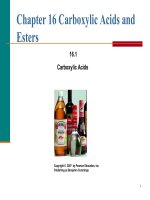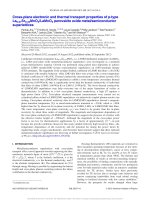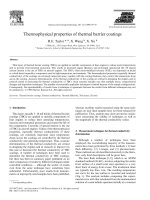Properties of carboxylic acids
Bạn đang xem bản rút gọn của tài liệu. Xem và tải ngay bản đầy đủ của tài liệu tại đây (189.25 KB, 70 trang )
20.6
20.6
Sources of Esters
Sources of Esters
CH
CH
3
3
COCH
COCH
2
2
CH
CH
2
2
CH(CH
CH(CH
3
3
)
)
2
2
O
O
Esters are very common natural products
Esters are very common natural products
3-methylbutyl acetate
3-methylbutyl acetate
also called "isopentyl acetate" and "isoamyl
also called "isopentyl acetate" and "isoamyl
acetate"
acetate"
contributes to characteristic odor of bananas
contributes to characteristic odor of bananas
Esters of Glycerol
Esters of Glycerol
R, R', and R" can be the same or different
R, R', and R" can be the same or different
called "triacylglycerols," "glyceryl triesters," or
called "triacylglycerols," "glyceryl triesters," or
"triglycerides"
"triglycerides"
fats and oils are mixtures of glyceryl triesters
fats and oils are mixtures of glyceryl triesters
RCOCH
RCOCH
CH
CH
2
2
OCR'
OCR'
O
O
CH
CH
2
2
OCR"
OCR"
O
O
O
O
Esters of Glycerol
Esters of Glycerol
CH
CH
3
3
(CH
(CH
2
2
)
)
16
16
COCH
COCH
CH
CH
2
2
OC(CH
OC(CH
2
2
)
)
16
16
CH
CH
3
3
O
O
CH
CH
2
2
OC(CH
OC(CH
2
2
)
)
16
16
CH
CH
3
3
O
O
O
O
Tristearin: found in many
Tristearin: found in many
animal and vegetable fats
animal and vegetable fats
Cyclic Esters (Lactones)
Cyclic Esters (Lactones)
(Z)-5-Tetradecen-4-olide
(Z)-5-Tetradecen-4-olide
(sex pheromone of female Japanese beetle)
(sex pheromone of female Japanese beetle)
O
O
O
O
H
H
H
H
CH
CH
2
2
(CH
(CH
2
2
)
)
6
6
CH
CH
3
3
Fischer esterification (Sections 15.8 and 19.14)
Fischer esterification (Sections 15.8 and 19.14)
from acyl chlorides (Sections 15.8 and 20.3)
from acyl chlorides (Sections 15.8 and 20.3)
from carboxylic acid anhydrides (Sections 15.8
from carboxylic acid anhydrides (Sections 15.8
and 20.5)
and 20.5)
Baeyer-Villiger oxidation of ketones (Section 17.16)
Baeyer-Villiger oxidation of ketones (Section 17.16)
Preparation of Esters
Preparation of Esters
20.7
20.7
Physical Properties of Esters
Physical Properties of Esters
Boiling Points
Boiling Points
Esters have higher
Esters have higher
boiling points than
boiling points than
alkanes because they
alkanes because they
are more polar.
are more polar.
Esters cannot form
Esters cannot form
hydrogen bonds to
hydrogen bonds to
other ester molecules,
other ester molecules,
so have lower boiling
so have lower boiling
points than alcohols.
points than alcohols.
CH
CH
3
3
CHCH
CHCH
2
2
CH
CH
3
3
CH
CH
3
3
CH
CH
3
3
COCH
COCH
3
3
O
O
CH
CH
3
3
CHCH
CHCH
2
2
CH
CH
3
3
OH
OH
28°C
28°C
57°C
57°C
99°C
99°C
boiling
boiling
point
point
Solubility in Water
Solubility in Water
Esters can form
Esters can form
hydrogen bonds to
hydrogen bonds to
water, so low molecular
water, so low molecular
weight esters have
weight esters have
significant solubility in
significant solubility in
water.
water.
Solubility decreases
Solubility decreases
with increasing number
with increasing number
of carbons.
of carbons.
CH
CH
3
3
CHCH
CHCH
2
2
CH
CH
3
3
CH
CH
3
3
CH
CH
3
3
COCH
COCH
3
3
O
O
CH
CH
3
3
CHCH
CHCH
2
2
CH
CH
3
3
OH
OH
~0
~0
33
33
12.5
12.5
Solubility
Solubility
(g/100 g)
(g/100 g)
20.8
20.8
Reactions of Esters:
Reactions of Esters:
A Review and a Preview
A Review and a Preview
with Grignard reagents (Section 14.10)
with Grignard reagents (Section 14.10)
reduction with LiAlH
reduction with LiAlH
4
4
(Section 15.3)
(Section 15.3)
with ammonia and amines (Sections 20.13)
with ammonia and amines (Sections 20.13)
hydrolysis (Sections 20.9 and 20.10)
hydrolysis (Sections 20.9 and 20.10)
Reactions of Esters
Reactions of Esters
20.9
20.9
Acid-Catalyzed Ester Hydrolysis
Acid-Catalyzed Ester Hydrolysis
maximize conversion to ester by removing water
maximize conversion to ester by removing water
maximize ester hydrolysis by having large excess of water
maximize ester hydrolysis by having large excess of water
equilibrium is closely balanced because carbonyl group of
equilibrium is closely balanced because carbonyl group of
ester and of carboxylic acid are comparably stabilized
ester and of carboxylic acid are comparably stabilized
Acid-Catalyzed Ester Hydrolysis
Acid-Catalyzed Ester Hydrolysis
RC
RC
OH
OH
O
O
+
+
R'
R'
O
O
H
H
RC
RC
O
O
R'
R'
O
O
+
+
H
H
2
2
O
O
H
H
+
+
is the reverse of Fischer esterification
is the reverse of Fischer esterification
Example
Example
HCl, heat
HCl, heat
+
+
H
H
2
2
O
O
O
O
CHC
CHC
O
O
CH
CH
2
2
CH
CH
3
3
Cl
Cl
+
+
CH
CH
3
3
CH
CH
2
2
O
O
H
H
O
O
CHCOH
CHCOH
Cl
Cl
(80-82%)
(80-82%)
Is the reverse of the mechanism for acid-
Is the reverse of the mechanism for acid-
catalyzed esterification.
catalyzed esterification.
Like the mechanism of esterification, it involves
Like the mechanism of esterification, it involves
two stages:
two stages:
1)
1)
formation of tetrahedral intermediate
formation of tetrahedral intermediate
(3 steps)
(3 steps)
2)
2)
dissociation of tetrahedral intermediate
dissociation of tetrahedral intermediate
(3 steps)
(3 steps)
Mechanism of Acid-Catalyzed
Mechanism of Acid-Catalyzed
Ester Hydrolysis
Ester Hydrolysis
First stage:
First stage:
formation of tetrahedral intermediate
formation of tetrahedral intermediate
First stage:
First stage:
formation of tetrahedral intermediate
formation of tetrahedral intermediate
RC
RC
OH
OH
OH
OH
O
O
R'
R'
+
+
H
H
2
2
O
O
RC
RC
O
O
R'
R'
O
O
H
H
+
+
water adds to the
water adds to the
carbonyl group of the
carbonyl group of the
ester
ester
this stage is
this stage is
analogous to the acid-
analogous to the acid-
catalyzed addition of
catalyzed addition of
water to a ketone
water to a ketone
Second stage:
Second stage:
cleavage of tetrahedral
cleavage of tetrahedral
intermediate
intermediate
Second stage:
Second stage:
cleavage of tetrahedral
cleavage of tetrahedral
intermediate
intermediate
RC
RC
OH
OH
OH
OH
O
O
R'
R'
+
+
R'
R'
O
O
H
H
H
H
+
+
RCOH
RCOH
O
O
Mechanism of formation
Mechanism of formation
of
of
tetrahedral intermediate
tetrahedral intermediate
Step 1
Step 1
Step 1
Step 1
RC
RC
O
O
O
O
R'
R'
••
••
•
•
•
•
•
•
•
•
••
••
O
O
•
•
•
•
+
+
H
H
H
H
H
H
Step 1
Step 1
Step 1
Step 1
RC
RC
O
O
O
O
R'
R'
••
••
•
•
•
•
•
•
•
•
••
••
O
O
•
•
•
•
+
+
H
H
H
H
H
H
••
••
RC
RC
O
O
O
O
R'
R'
••
••
•
•
•
•
+
+
H
H
•
•
•
•
O
O
•
•
•
•
H
H
H
H
Step 1
Step 1
Step 1
Step 1
••
••
RC
RC
O
O
O
O
R'
R'
••
••
•
•
•
•
+
+
H
H
carbonyl oxygen is
carbonyl oxygen is
protonated because
protonated because
cation produced is
cation produced is
stabilized by electron
stabilized by electron
delocalization
delocalization
(resonance)
(resonance)
RC
RC
O
O
O
O
R'
R'
••
••
•
•
•
•
+
+
H
H
••
••
Step 2
Step 2
Step 2
Step 2
••
••
•
•
•
•
O
O
•
•
•
•
H
H
H
H
RC
RC
O
O
O
O
R'
R'
••
••
•
•
•
•
+
+
H
H
Step 2
Step 2
Step 2
Step 2
••
••
•
•
•
•
O
O
•
•
•
•
H
H
H
H
RC
RC
O
O
O
O
R'
R'
••
••
•
•
•
•
+
+
H
H
RC
RC
OH
OH
O
O
R'
R'
••
••
•
•
•
•
•
•
•
•
••
••
O
O
•
•
•
•
+
+
H
H
H
H
Step 3
Step 3
Step 3
Step 3
•
•
•
•
O
O
•
•
•
•
H
H
H
H
••
••
RC
RC
OH
OH
O
O
R'
R'
••
••
•
•
•
•
•
•
•
•
O
O
•
•
•
•
H
H
H
H
+
+
Step 3
Step 3
Step 3
Step 3
•
•
•
•
O
O
•
•
•
•
H
H
H
H
••
••
RC
RC
OH
OH
O
O
R'
R'
••
••
•
•
•
•
•
•
•
•
O
O
•
•
•
•
H
H
H
H
+
+
O
O
•
•
•
•
H
H
H
H
H
H
+
+
••
••
RC
RC
OH
OH
O
O
R'
R'
••
••
•
•
•
•
•
•
•
•
O
O
•
•
•
•
H
H
••
••









